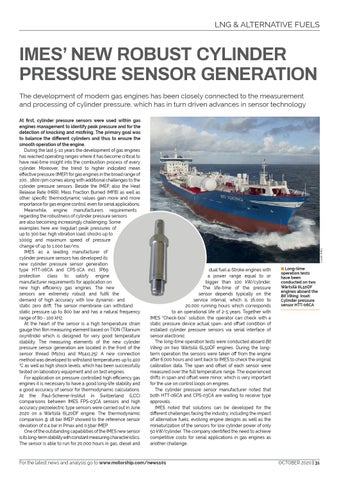LNG & ALTERNATIVE FUELS
IMES’ NEW ROBUST CYLINDER PRESSURE SENSOR GENERATION At first, cylinder pressure sensors were used within gas engines management to identify peak pressure and for the detection of knocking and misfiring. The primary goal was to balance the different cylinders and thus to ensure the smooth operation of the engine. During the last 5-10 years the development of gas engines has reached operating ranges where it has become critical to have real-time insight into the combustion process of every cylinder. Moreover, the trend to higher indicated mean effective pressure (IMEP) for gas engines in the broad range of 100... 1800 rpm comes along with additional challenges to the cylinder pressure sensors. Beside the IMEP, also the Heat Release Rate (HRR), Mass Fraction Burned (MFB) as well as other specific thermodynamic values gain more and more importance for gas engine control, even for serial applications. Meanwhile, engine manufacturers requirements regarding the robustness of cylinder pressure sensors are also becoming increasingly challenging. Some examples here are (regular) peak pressures of up to 300 bar, high vibration load, shocks up to 1000g and maximum speed of pressure change of up to 1.000 bar/ms. IMES as a leading manufacturer of cylinder pressure sensors has developed its new cylinder pressure sensor generation type HTT-06CA and CPS-1CA incl. IP69 protection class to satisfy engine manufacturer requirements for application on new high efficiency gas engines. The new sensors are extremely robust and fulfil the demand of high accuracy with low dynamic- and static zero drift. The sensor membrane can withstand static pressure up to 800 bar and has a natural frequency range of 80 - 100 kHz. At the heart of the sensor is a high temperature strain gauge thin film measuring element based on TION (Titanium oxynitride) which is designed for very good temperature stability. The measuring elements of the new cylinder pressure sensor generation are located in the front of the sensor thread (M10x1 and M14x1.25). A new connection method was developed to withstand temperatures up to 400 °C as well as high shock levels, which has been successfully tested on laboratory equipment and on test engines. For application on pressure controlled high efficiency gas engines it is necessary to have a good long-life stability and a good accuracy of sensor for thermodynamic calculations. At the Paul-Scherrer-Institut in Switzerland (LCC) comparisons between IMES FPS-03CA sensors and high accuracy piezoelectric type sensors were carried out in June 2020 on a Wärtsilä 6L20DF engine. The thermodynamic comparison @ 18 bar IMEP showed to the reference sensor deviation of 0.4 bar in Pmax and 0.5bar IMEP. One of the outstanding capabilities of the IMES new sensor is its long-term stability with constant measuring characteristics. The sensor is able to run for 20,000 hours in gas, diesel and
Credit: IMES
The development of modern gas engines has been closely connected to the measurement and processing of cylinder pressure, which has in turn driven advances in sensor technology
dual fuel 4-Stroke engines with a power range equal to or bigger than 100 kW/cylinder. The life-time of the pressure sensor depends typically on the service interval, which is 16,000 to 20,000 running hours which corresponds to an operational life of 2-5 years. Together with IMES “Check-box” solution, the operator can check with a static pressure device actual span- and offset condition of installed cylinder pressure sensors via serial interface of sensor electronic. The long-time operation tests were conducted aboard Bit Viking on two Wärtsilä 6L50DF engines. During the longterm operation the sensors were taken off from the engine after 6,000 hours and sent back to IMES to check the original calibration data. The span and offset of each sensor were measured over the full temperature range. The experienced drifts in span and offset were minor, which is very important for the use on control loops on engines. The cylinder pressure sensor manufacturer noted that both HTT-06CA and CPS-03CA are waiting to receive type approvals. IMES noted that solutions can be developed for the different challenges facing the industry, including the impact of alternative fuels, evolving engine designs as well as the miniaturization of the sensors for low cylinder power of only 50 kW/cylinder. The company identified the need to achieve competitive costs for serial applications in gas engines as another challenge.
For the latest news and analysis go to www.motorship.com/news101
8 Long-time operation tests have been conducted on two Wärtsilä 6L50DF engines aboard the Bit Viking. Inset: Cylinder pressure sensor HTT-06CA
OCTOBER 2020 | 31



